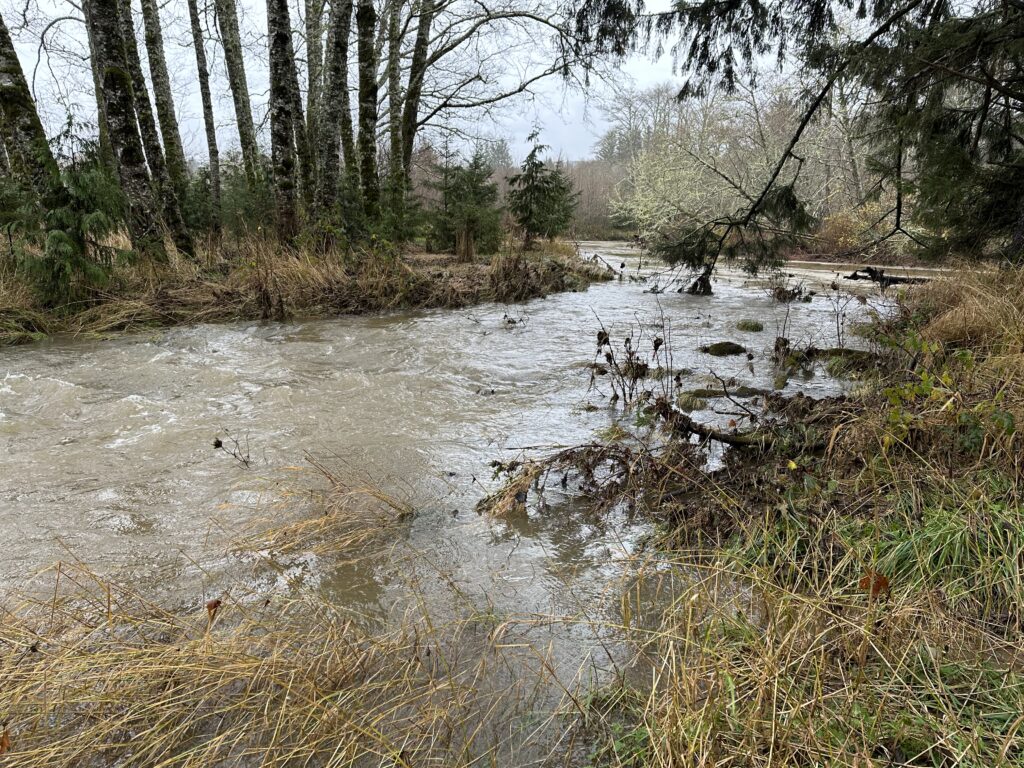On the northern Oregon Coast, we’re no strangers to flooding and high-water events that close schools, roads, stores and other establishments for hours or days at a time.
Part of what makes them so complex is the interaction between the tides, the rivers, and the rain in this region we call home. Depending on whether it’s high tide or low tide, a certain amount of rain may or may not lead to the outcomes mentioned above.
From an ecological standpoint, flooding is an important and wonderful phenomenon. It spreads water and nutrients across forests, wetlands, creeks, and lakes. We get to see these positive outcomes at play at our habitat reserves on the Oregon Coast, many of which include wetlands and floodplains.
But Circle Creek Conservation Center—a habitat reserve spanning about 364 acres—is an especially important example of a place where several ecological and social factors converge.
Active Restoration at Circle Creek in 2013
Circle Creek is located off Rippet Road, just south of Seaside and in close proximity to U.S. Highway 101, a road that cuts through the Necanicum River floodplain in that area.
In 2013, NCLC and our partners at Clatsop County and Oregon Department of Transportation (ODOT) completed a landmark floodplain-restoration project at the site, allowing the land to naturally flood during wintertime high-water events and mitigating flooding of the adjacent highway.
The project involved removing a levy from the Necanicum River, in effect letting nature’s floodplain gather the floodwaters and reducing water accumulation on the highway by approximately 12 inches. It was a natural solution to help the wetland at Circle Creek revert back into the sort of sponge it’s designed to be.
Now, when the highway becomes inundated with rainwater, it is only during extreme flood events, such as the one that took place in early December.
Meanwhile, the seasonal floods continue to positively influence the environment in and surround the reserve. The excess water invites even more wildlife onto the land, including waterfowl and juvenile salmon, which find refuge in the off-channel sloughs that form on the floodplain.

Observing Change at Circle Creek
It’s been a wonderful experience for our team at NCLC to develop a relationship to the land and waters at Circle Creek Conservation Center and contribute actively to the area’s restoration.
Site Steward Jeff Roehm also has a long-term relationship with the reserve, having grown up in Seaside and known the family that previously owned the property.
During his years as a volunteer and his countless visits to Circle Creek, he’s witnessed the evolution of the landscape and the waterways.
“There is a lot of channeling going on out there,” he says.
One interesting feature on the property is an area called the avulsion. In floodplain geology, an avulsion is where the river changes channels. In this case, that involves the Necanicum River.
“The Necanicum is partially changing its course and connecting with Circle Creek,” Jeff says. During flood events, the Necanicum goes, in part, through Circle Creek, taking a shortcut to the nearby ocean. He adds that every year, the avulsion “is slowly eroding away,” and may someday become “the new main channel.”
These are observations at this point, but inevitably, the landscape of the reserve will change over time, as it is shaped by the Necanicum River, Circle Creek, and other channels of water. It’s a fascinating experience to watch that happen.
Developing a bond to Circle Creek would be natural for anyone in his position, Jeff says. It’s especially enjoyable to be outside at the reserve, providing stewardship and care for an area that’s connected to such deep-seated memories and that “harkens back” to his childhood.
“It’s such an interesting place, once you take the time to go out there and start snooping around,” he says.
Comments
Particularly enjoyed Jeff Roehm’s analysis.
Jeff is a wonderful Site Steward, so dedicated and passionate. We are really fortunate to have his eyes and ears on the ground on such a regular basis and to benefit from his knowledge and insights!